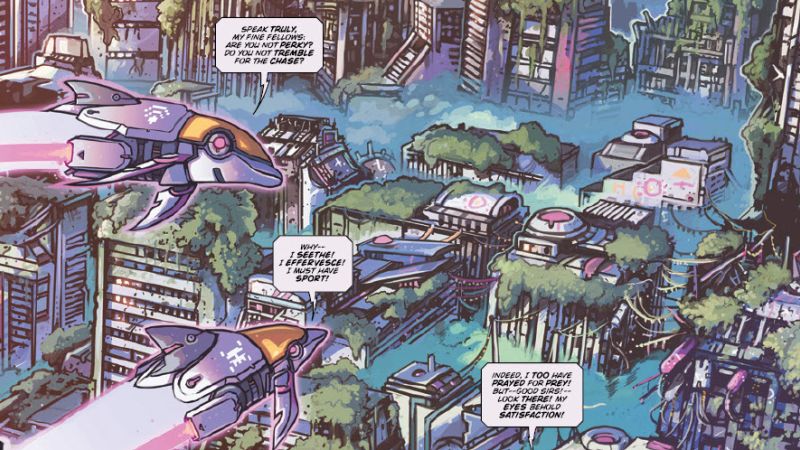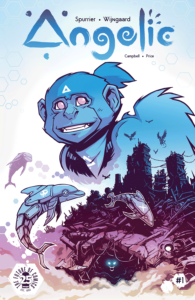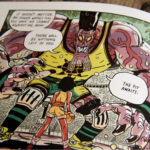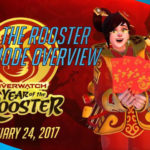
Angelic #1-3
Writer: Simon Spurrier
Art: Caspar Wijngaard
Letters: Jim Campbell
Designs: Emma Price
A review by Malcolm Derikx
 Usually when someone uses the term, “post-apocalypse” to describe a piece of fiction, my guard goes up. Shoulders tensed, I think about all those dreary rust-brown and ash-grey wastelands, the muddled, interchangeable color palette of every piece of post-apocalyptic media from Fallout, to AMC’s The Walking Dead. So reading Spurrier and Wijngaard’s Angelic, I can’t help but think the title is rather appropriate. A breath of fresh air, it’s this weird pastel-colored Planet of the Apes by way of Watership Down epic, and suddenly I care about the post-apocalypse again. The future of the genre seems… brighter. Oddly enough.
Usually when someone uses the term, “post-apocalypse” to describe a piece of fiction, my guard goes up. Shoulders tensed, I think about all those dreary rust-brown and ash-grey wastelands, the muddled, interchangeable color palette of every piece of post-apocalyptic media from Fallout, to AMC’s The Walking Dead. So reading Spurrier and Wijngaard’s Angelic, I can’t help but think the title is rather appropriate. A breath of fresh air, it’s this weird pastel-colored Planet of the Apes by way of Watership Down epic, and suddenly I care about the post-apocalypse again. The future of the genre seems… brighter. Oddly enough.
Angelic is set on an Earth inhabited entirely by genetically modified animals after a devastating war has wiped out humanity. Qora, our protagonist, is a young flying monkey. Fed up with her tribe’s strict traditions she strikes out on her own for answers. She rather quickly finds herself in over her head, and on a dangerous quest to find a lost relic in the ruins of human civilization.
In a world of flying tech-dolphins, and winged monkeys living atop bombed-out skyscrapers, the world-building of Angelic is incredibly unique and a strong draw. But this also serves as a double-edged sword- Spurrier tosses us into this highly original world without much of a safety net. All the characters speak with species-specific terminology and slang, which can be alienating and make it hard to tell what’s going on, especially in the first issue. The tech-dolphins tend to get excited and nonsensical when they take-off through the air for instance, and Qora and The Complainer butt heads frequently over misinterpreting each others words, or simply not having compatible vocabulary as they are from different species. Some conversations can seem downright nonsensical without a second read-through.
In time however, this Clockwork Orange-style of world-building creates some rewarding reveals for those willing to stick with it; the identity of the mysterious “Mans” in Issue #1, and the “pooping snake” sign Qora finds in Issue #3 (aka, a sign with a simple “?”) are just some examples of how Spurrier uses the language of the characters to create an identifiable, but truly alien world. Angelic’s post-apocalypse feels as if the world has truly moved on and evolved in humanity’s absence, and that’s really cool to see.
As a protagonist, Qora’s inquisitive nature helps us wade into this complex world, and allows Spurrier to address the more confusing aspects of it. Qora is a likable protagonist- she’s brave and adventurous, and her refusal to blindly obey is what she sees to be her greatest weakness- and that’s exactly what makes her a compelling character to follow. Alfer, the leader of Qora’s tribe meanwhile, is the only disappointingly bland spot thus far. His particular brand of villainy, abusing subordinates and parroting religious doctrine and the value of blind faith, is a little cookie-cutter compared to the other characters, such as The Fazecat, a bloodthirsty feline stalking the toxic ruins of civilization.
While the world of Angelic has evolved in many ways, it’s stayed the same in so many others. Despite humanity being long gone, unfortunate “isms” still remain, like scars, in the tribes across Angelic’s world. From the strictly patriarchal monkey tribe, to the old battle lines drawn between the monkeys and the mans, (implied to be the remaining foot-soldiers in the war that originally ended humanity), it seems like the story of Angelic gearing up to be one of questioning blind faith, and trying to prevent the past from repeating itself.
While the story is conceptually impressive, it’s a fact that this book lives or dies on Caspar Wijngaard’s artwork. Under a different artist, Spurrier’s vision could easily have been lost. But Wijngaard’s bubble-gum apocalypse is truly breathtaking, with copious amounts of blues and pinks and some truly gorgeous splash pages thus far. I really applaud the creative team for going with a very distinct look for their post-apocalyptic future, and sticking to it. The characters can bounce from being cute to terrifying between panels and it Wijngaard makes it feel natural. A completely realistic portrayal of animals, such as in Morrison’s We3, would have felt like a bit of a misstep for Angelic. The visual style works together with the narrative, slightly whimsical when it wants to be, pretty dark and uncomfortable the rest of the time.
Wijngaard truly comes into his own here, and while the character designs are beautifully complex, I was never confused on what was occurring on the actual page. The story flows and moves well- speaking of the designs, props must be given to Emma Price for her work- the various animals and tribes encountered in the first three issues all look wonderfully distinct from one another. Specifically, the design for The Complainer and the rest of the Mans, which reminds me of the robots from WALL-E, are really fun.
Verdict:
All in all, this is a strong BUY from me. I was pleasantly surprised by the world-building and originality in Angelic, and Wijngaard’s art is beautiful sci-fi. There’s a little bit of a barrier-of-entry issue, but Angelic’s plot is progressing at a decent clip, with real developments unfolding in each of the three issues released thus far.


![[REVIEW] I COULD WATCH THIS ALL DAY! ‘HAWKEYE’ SEASON 1](https://geekd-out.com/wp-content/uploads/2021/12/apt-106-12941_r2-150x150.jpg)
